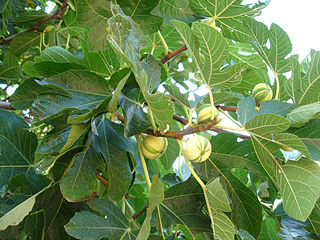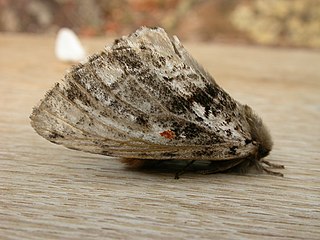Related Research Articles

Variegation is the appearance of differently coloured zones in the leaves, and sometimes the stems, of plants.

The Field Elm cultivar Ulmus minor 'Atinia Variegata', the Variegated-leaved common English Elm, formerly known as U. procera 'Argenteo-Variegata' and described by Weston (1770) as U. campestris argenteo-variegata, is believed to have originated in England in the seventeenth century and to have been cultivated since the eighteenth. The Oxford botanist Robert Plot mentioned in a 1677 Flora a variegated elm in Dorset, where English Elm is the common field elm. Elwes and Henry (1913) had no doubt that the cultivar was of English origin, "as it agrees with the English Elm in all its essential characters". At the Dominion Arboretum, Ottawa, the tree was listed as U. procera 'Marginata', as the variegation is sometimes most obvious on leaf-margins.
The Wych elm cultivar Ulmus glabra 'Latifolia Aureo-Variegata' was first mentioned by Neubert in Deutsches Magazin für Garten- und Blumenkunde 1871 as Ulmus campestrisL.latifolia aureo-variegata.

The Field Elm cultivar Ulmus minor 'Argenteo-Variegata' or simply 'Variegata', known in Australasia and North America as Silver Elm or Tartan Elm, is said to have been cultivated in France from 1772. Green noted that variegated forms of Field Elm "arise frequently, and several clones may have been known under this name". Dumont de Courset (1802) listed an U. campestris var. glabra variegata, Loudon (1838) an U. nitens var. variegata, and Wesmael (1863) an U. campestris var. nuda microphylla variegata.
The American Elm cultivar Ulmus americana 'Folia Aurea Variegata' was first described by Jäger in Die ziergehölze der Gärten und parkanlagen, 548, 1865.

The Field Elm cultivar Ulmus minor 'Viminalis Pulverulenta' (:'powdery'), also known as 'Viminalis Variegata', a variegated form of U. minor 'Viminalis', was first mentioned by Dieck, in 1885 as U. scabra viminalis pulverulentaHort., but without description. Nursery, arboretum, and herbarium specimens confirm that this cultivar was sometimes regarded as synonymous with U. minor 'Viminalis Marginata', first listed in 1864, which is variegated mostly on the leaf margin. It is likely, however, that 'Pulverulenta' was the U. 'Viminalis Variegata', Variegated Twiggy-branched elm, that was listed and described by John Frederick Wood, F.H.S., in The Midland Florist and Suburban Horticulturist 1847 and 1851, pre-dating both Kirchner and Dieck. Wood did not specify the nature of the variegation.
Callisthenia is a genus of moths in the subfamily Arctiinae. The genus was erected by George Hampson in 1900.
Paracles is a genus of moths in the subfamily Arctiinae. The genus was described by Francis Walker in 1855. The species range from Panama to Patagonia, with quite a few in the southern temperate region of South America.

Lymantria is a genus of tussock moths in the family Erebidae. They are widely distributed throughout Europe, Japan, India, Sri Lanka, Myanmar, Java, and Celebes. The genus was erected by Jacob Hübner in 1819.

Pseudosphex is a genus of tiger moths in the family Erebidae. The genus was erected by Jacob Hübner in 1818. These moths are mimics of a variety of Hymenoptera. The prefix pseudo means "false", and Sphex is a genus of wasps.

Acanthaspis is a genus of assassin bugs. Members of the genus are known to disguise themselves by attaching bits of debris to aid in camouflage.
Euhagena is a genus of moths in the family Sesiidae.

Aglaosoma variegata, the patterned notodontid, is a species of moth of the family Thaumetopoeidae first described by Francis Walker in 1855. It is known from the Australian states of New South Wales, Queensland and Victoria.
Callisthenia plicata is a moth of the subfamily Arctiinae first described by Arthur Gardiner Butler in 1877. It is found in the Amazon region, Peru and Espírito Santo, Brazil.
Syntomidopsis variegata is a moth in the subfamily Arctiinae. It was described by Francis Walker in 1854. It is found on Jamaica.
Cotana is a genus of moths in the family Eupterotidae.
References
- ↑ Savela, Markku (October 26, 2015). "Callisthenia variegata (Walker, [1865])". Lepidoptera and Some Other Life Forms. Retrieved October 17, 2019.
| | This Lithosiini-related article is a stub. You can help Wikipedia by expanding it. |